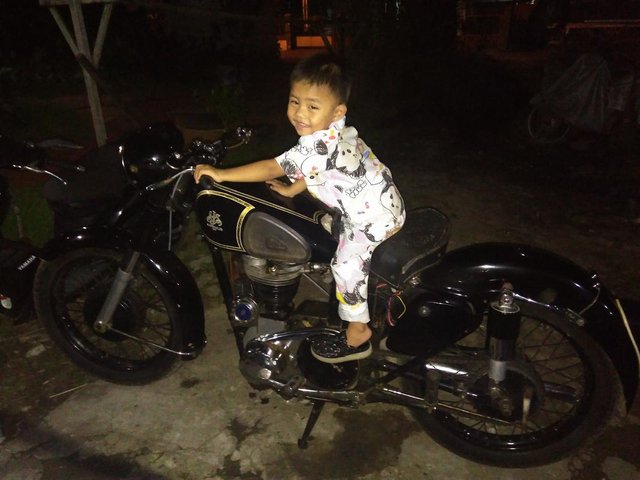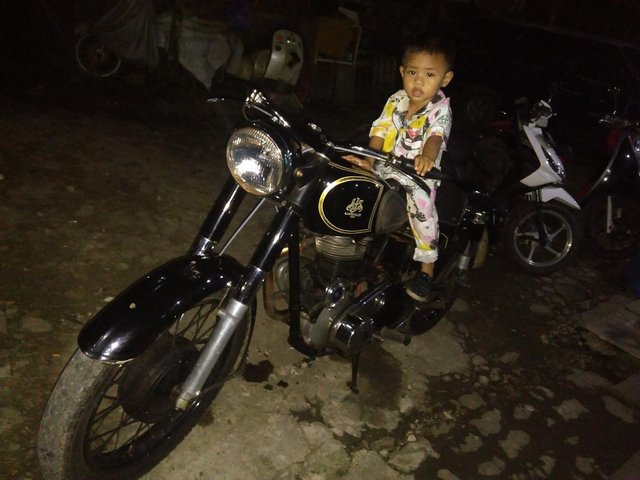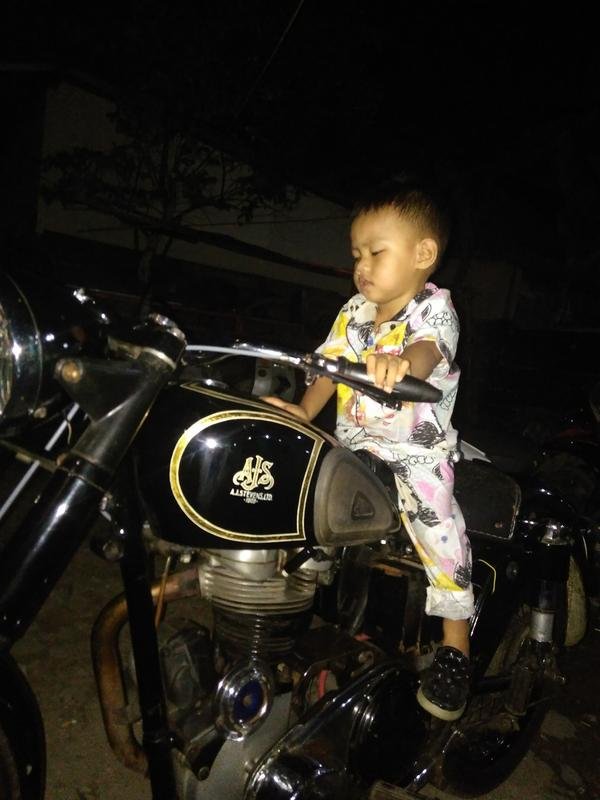my son photographed in a rare motorcycle, motorcycle AJS in 1954
hi steemian ..,
my son looks dashing selfi in this rare motor




AJS motor history:
AJS is a name (read: brand) of a British motorcycle that was born in 14 NOPEMBER 1909. AJS is made by four of the five brothers Stevens (a child of Blacksmith) by Harry, George, Jack and Joe Stevens. Initially they only made engines for motorcycles in 1897. To patent the name of the machine, they introduced a new name for the motor. After a variety of considerations, finally using the initial name of the first brother is Jack who has the name Cristian Albert John. Consequently was born a name AJS which stands for Albert John Stevens.
Harry began designing the first two machines called model 'A' and model 'B'. The 'A' model is a cheaper engine, and comes with a 2.5hp single cylinder, valve side engine and direct drive belt.
Joe Stevens, Harry's father, George, John Albert ('Jack'), and Joe Stevens Junior, is an engineer owned by Stevens Screw Company Ltd, in Wednesfield, near Wolverhampton. Stevens had a reputation for engineering quality before the company built its first motorcycle in 1897, using a four-stroke single-cylinder Mitchell imported from the United States. Shortly thereafter, Stevens began making machines, ranging from with the better-built versions of Mitchell but the family soon developed their own designs, including the twin-twin and V-twin, which were sold as exclusive machines to other manufacturers, including Werner, Wolf and Clyno.
In 1909, after Wearwell motorcycle equipped with Stevens side-valve single cylinder engine won trophies to run 24 hours non-stop in 1909, Jack Stevens decided to contest Trophy tourists on the Isle of Man. A new company, AJ Stevens & Co. (AJS), was established, with a place on Retreat Street, Wolverhampton, to produce motorcycles and the first model appeared on the Motorcycles Show in 1910. The two-speed, 298 cc side-valve engine, to come within the 300 cc limit for a junior machine on the Isle of Man TT 1.911 race and slightly larger than the 292 cc used for proprietary engines. Jack Stevens came 16 on the AJS official entry, a place behind private JD Corke owner on an identical machine.
AJS did not question TT 1912 as it was busy fulfilling the demand for its products, but 10 in Junior 1913. With the junior high school raised to 350 cc in 1914, AJS motorcycles have grown to 349 cc, with four speed gears and end drive chains. AJS won first, second, third, fourth and sixth in Isle Man TT 1914 junior racing that year. The old Screw Company's facility could not cope with demand and with the company returning as AJ Stevens (1914) Ltd., AJS moved into a new factory built around Graiseley House on the outskirts of Wolverhampton. The 349 cc engine (known as 2 3/4 hp) is the bestseller but the company also produces 800 cc (6 hp) V-twin.
On November 3, 1916, the Munitions Department banned the production of non-military motorcycles, and AJS went to manufacturing ammunition, but in 1917 the beginning of the Ministry received orders from Russia for military vehicles, and AJS was given a contract to produce part of the sequence with which Model AJS D machines. This AJS was busy until the Department of Munitions restrictions were lifted in January 1919.
When production 350 back in 1920, it was much better. The side-valve engine is replaced by a new overhead-valve design that produces 10 bhp. It also has an internal expanding brake and a primary drive chain. Cyril Williams won the first post of the 1920 Isle of Man TT Junior race in his 350th, although he had to drive the motorcycle home for nearly four miles (mostly downhill) after the breakdown. AJS took the first four places on the Isle of Man TT 1921, and Howard R Davies got better second place in junior by winning Senior on the same 350 cc AJS. This is the first time 350 has won the 500cc TT Senior race. In 1922 Manxman Tom Sheard won Junior on AJS, with G Grinton, also on AJS, taking the second.
The 1922 engine is a classic design that will become famous as 'Big Port' because of its large diameter exhaust port and pipe (initially 1 ⅝ inches, but changed in consecutive years). The OHV 350 will be a mainstay of the company's racing efforts until 1927 and in the form of production (first offered to the public in 1923), also the most popular AJS sports motorcycle throughout the 1920s. At the moment, the company produces a comprehensive range of other models ranging from 250 to 1,000cc. These are generally given a model number, plus a letter to indicate the year of manufacture (eg, E means 1924, F 1925, G 1926).
In 1929 for example, the AJS range consists of: M1 Deluxe 996 cc side-valve V-twin £ 76/10/0, M2 Standard 996 cc side-valve V-twin £ 66/0/0, M3 Deluxe Touring 349 cc side -valve single £ 48/10/0, M4 Deluxe Sporting 349 cc side-valve single £ 48/10/0, M5 Standard Sporting 349 cc single side valve £ 45/0/0, M6 349 cc overhead-single valve £ 54/10/0 (twin port), £ 52/0/0 (single port); MR6 Special sports 349 cc overhead-single valve £ 62/0/0, 349 cc single overhead camshaft £ 62/0 / 0, 498 cc M8 overhead-single valve £ 62/0/0 (port twin), £ 59 / 10/0 (single port); MR8 Special sports 498 cc overhead single-valve £ 72/0/0, M9 Deluxe Touring 498 cc side-valve £ 54/0/0, 498 cc 498 cc overhead single-camshaft £ 72/0/0, M12 Lightweight 248 cc side -valve single £ 39/17/6. Some of these are intended to attract one of the 12 AJS sidecars also offered, including sports models, tours and commercials. [5]
In 1927, it has become clear that push-rod overhead-valve designs are becoming dated in racing, so AJS introduces two new chain-driven overhead-camshaft racing models, the 349 cc K7 and 498 cc K10. Jimmy Simpson drove 350 to third place in SMP TT and won the race in Europe, but in 1928 AJS used a valve overhead engine at TT. In 1929 there were two more machines with overhead cam, this time 349 cc M7 and cc 498 M10. Wal Handley came second at TT 1929 Young AJS. The following year Jimmie Guthrie won the Lightweight TT 1.930 at 250 cc AJS.
In 1931, AJS S3 V-twin was released, a 496 cc V-twin transverse tourer with a main shaft drive alloy head and cylinder. [7] It's expensive to develop and slow to sell. Despite the 117 world records, the AJS company is now in financial trouble.
Under the AJS AMC badge may have been put on "Matchless buns and butter" motorcycles, but the Colliers were aware of the AJS racing heritage, and used the name on some innovative racing machines. This racing bike keeps AJS's name alive.
In 1935, at the Olympia Show, air-cooled SOHC AJS 50 ° V4 was shown, the full version of the road going, which did not make it into production. In 1936 Harold Daniell rode a supercharged racing version on the Isle of Man TT Senior, but despite his peak high speed, he lacked acceleration.
In 1939, the water-cooled and supercharged 495 cc AJS V4 version was built to compete with the supercharged BMW then dominate the race. The year 1939 the V4 dry sump is the bike for the first round of the Ulster Grand Prix course at over 100 mph (160 km / h). It weighs 405 pounds (184 kg). and the top speed is 135 mph (217 km / h). Then World War II intervened.
In the late 1940s and early 1950s, the AJS Hedgehog, the 500 cc front facing the parallel twin, and the AJS 7R (32 bhp, 350 cc single OHC) were running alongside their AMC enclosure with the Matchless G50 (effective 500 cc 7R) and 1951, Matchless G45 (a 500 cc vertical twin). The Porcupine AJS has been designed for supercharging, before the rules changed banning supercharged racing bikes, but nevertheless, Les Graham won the 1949 World Championship on Porcupine E90 unsupercharged AJS 500 cc.
In 1951 AJS development engineer Ike Hatch developed a 75 bore 75 × 78 mm stroke, three-valve-head bhp version making 7R 36 (27 kW). It's called AJS 7R3, and Ike's response to the multi-cylinder Italian racer. They do pretty well in their first year, not as well as the second. During 1954 Jack Williams, the team manager worked, developed the bike further, lowered the engine in the frame, and made several tuning changes that gave 40 bhp (30 kW) @ 7800 rpm. Soon won the first two rounds of the World Championships and took first on the Isle of Man TT. This is a special factory, but one has survived, and the second has been reconstructed from spare parts.
Associated Motorcycles and the name AJS finally ended with Norton-Villiers in 1966. In late 1968 Plumstead worked at Burrage Grove, where machines from Wolverhampton plants and frames from Manchester plants were assembled into complete machines, presented with the Greater London Council purchase order required. Plumstead works closed in July 1969. It is believed that the production of the G15 series was discontinued late in 1968 (model 1969) with the sample being offered sold through 1969. The AJS 33 model was the last badged four-stroke AJS produced.
AJS two-stroke and Norton Villiers
AJS was acquired by Villiers Norton Group. In 1967 Villiers decided that instead of engineers, they would build and launch their own motorcycles using the Starmaker 250 engine as a base. AJS will be the name applied. Villiers has plans to build various scramblers and all 250 road counter racers. From 1962 Cotton motorcycles are the main customers for 250 Starmaker engines. The 250 Starmaker engine is used in Cobra random scramblers and Telstar racers. Cotton is therefore heavily involved in the development of Starmaker machines. A strong relationship between the two factories exists, partly through Cotton engineer Fluff Brown.
Fluff Brown, being a sharp and dedicated scrambler, works primarily on randomizing projects and supporting factory riders.
Peter Inchley, a recognized two-stroke expert from Ariel and BSA was involved with the Ras 250 Road project. Peter drove a 6-speed BULTACO based, 250 Villiers Starmaker-powered exclusively for 3rd place at TT 1966 Light. Some pre-production AJS 250 Racers were built and the project came in 1967 after a second TT failed attempt. The random project continued with considerable success.
In late 1967, a special project was done with Stormer. Four bikes are built on Marston Road, all equipped with a splash retard on the exhaust and a basic lighting system. Three of them have 250 cc machines and badged as AJS machines. The fourth has a "360" engine (actually only 334 cc) and is badged as a Matchless. This bike is probably the last one built with a Matchless and Matchless 2-stroke badge only. Four bikes were taken by the members of Royal Air
In 1931 the group Colliers bought AJS, and in 1938 AMC took over and engineered many Matchless-based model badges. AJS Pascaperang racing machines include 350cc 7R wonderul (original Racer Boy) and parallel Porcupine twins. When Amalgamated Motorcycles failed in 1966 the marque was purchased by Holdings Manganese Bronze who formed the group of Norton Villiers. NV introduced the AJS competition two-stroke engine powered by Villiers Starmaker engine, and when the difficulties experienced by the company in the early 1970s AJS name was acquired by Fluff Brown who moved the business to Hampshire in 1974.
thank you for visiting.
vote, resteem, coment if friends like.
greeting steemit ...
Congratulations @containeri! You received a personal award!
You can view your badges on your Steem Board and compare to others on the Steem Ranking
Do not miss the last post from @steemitboard:
Vote for @Steemitboard as a witness to get one more award and increased upvotes!